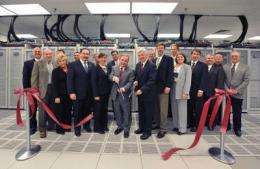Defense-scale supercomputing comes to alternative energy research

A new supercomputer that more quickly models the most efficient ways to harness energy from the sun, wind and other renewable resources is now operating at Sandia National Laboratories.
Red Mesa, a 180-teraflop computing platform, is a collaboration between Sandia and the National Renewable Energy Laboratory (NREL). The two labs dedicated the supercomputer earlier this month, along with representatives from Sun/Oracle and Intel corporations and the Department of Energy's Sandia Site Office.
The work for the first time brings defense-scale computing to bear on alternative energy projects that otherwise could take months or even years to complete if researchers had to rely on more limited computing resources or on physical testing.
Joe Polito, Sandia vice president of Enterprise Transformation, called Red Mesa "a state-of-the-art computing platform to address pressing energy problems for the country, using the most energy-efficient supercomputer in the country."
Megan McCluer, DOE program manager for wind and hydropower technologies, said, "The Red Mesa platform will provide the speed and scale needed to perform large-scale computations targeted toward the continued improvements of clean energy technologies."
Red Mesa, when combined with its architecturally similar Sandia parent Red Sky, reaches a total speed of 500 teraflops, making it the 10th fastest computer in the world.
Already, Red Mesa has enabled NREL researchers to solve a corn-stalk-to-energy problem in just six weeks. The problem formerly would have taken six months.
"We need supercomputing to help us transform forestry and agricultural by-products into fuels and energy more rapidly and economically," said Steve Hammond, director of NREL's Computational Science Center. "And we need to learn how to minimize waste products like tar in the biomass gasification process. They're expensive to clean up and we shouldn't be creating them in the first place."
In addition to its "green" targets, Red Mesa's operational innovations make it a kind of "green" machine, Sandia manager John Zepper said.
Innovating on the newest technology, the team dramatically improved Red Mesa's efficiency compared with other supercomputers. A first-of-its-kind innovation is the Glacier Door — a door capping each cabinet that keeps cooling mechanisms within a few inches of the heat source. With the improved system, air exiting the array of supercomputer cabinets is actually slightly cooler than when it came in.
Other improvements included a better electrical power distribution system that allowed for easier installation and removal of electrical wiring. The Red Mesa machine is configured with an all-optical connector-based Infiniband network.
"Our changes, both in software and hardware, will save millions of dollars over the life of this machine," said Zepper.
These changes only came about, noted Rob Leland, director of Sandia's Computations, Computers and Math center, because "vendors were willing to take technical and economic risks that permitted us to deploy a dozen significant innovations. This combination of off-the-shelf technology and accompanying innovations represented quite a big risk and vendors were willing to go on this journey with us because they saw strategic value to their business. This innovative approach delivers great value to the taxpayer."
Oracle, prime contractor to Red Mesa, is introducing the same innovations in smaller Oracle machines.
Margie Tatro, director of Sandia's Energy Systems Center, said, "I want to thank DOE, as well as the urgency and relevancy of our partners in the private sector, for helping Sandia and NREL overcome obstacles and make this happen."
Provided by Sandia National Laboratories
















